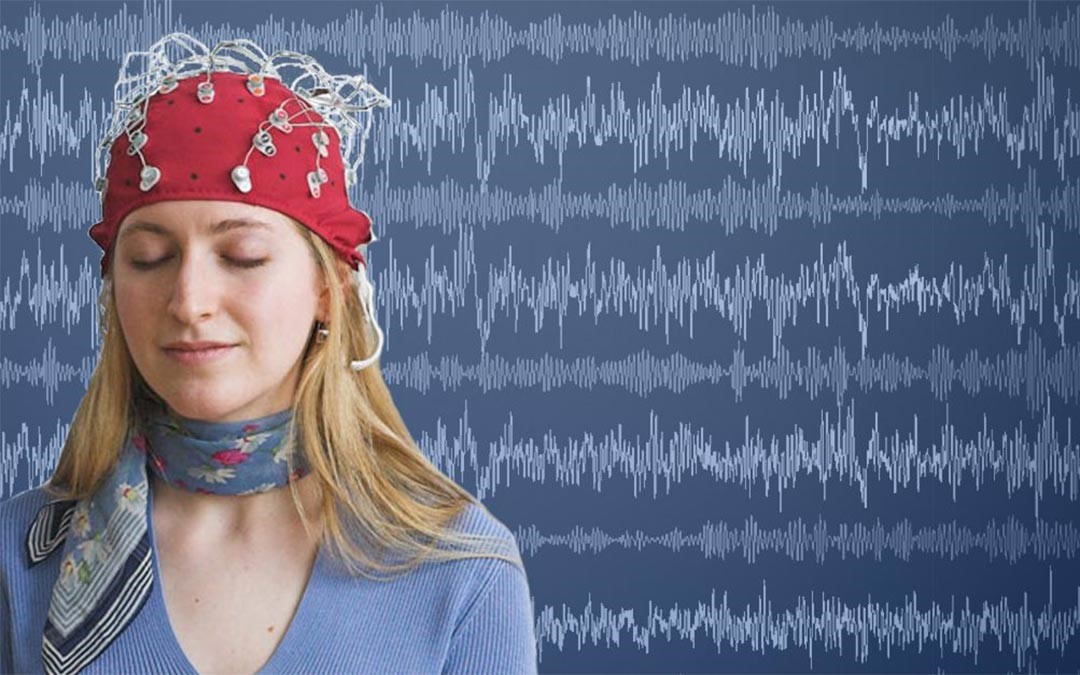By Craig Pearson
Reprinted from the Uncarded Blog
A fourth-year college student named Amanda walks into the laboratory and drops her backpack on a nearby chair. She has just finished her afternoon class on human resource management. The lab director, Dr Fred Travis, greets her and motions her to take a seat in front of the window. As they exchange small talk, Travis places a red cloth cap over the top of her head. It looks something like a ski cap, except for one thing―it has 32 sensors attached to it, connected to an electroencephalograph (EEG) machine that will measure the electrical activity of Amanda’s brain at 32 different points.

He monitors Amanda’s brainwave activity for the next few minutes to establish baseline readings. Then he asks Amanda to close her eyes and continue to sit quietly for a few more minutes. All the while wavy lines are moving across the computer screen, left to right.
Then he quietly instructs her to begin her practice of Transcendental Meditation―and in less than a minute, the waves change dramatically.
It’s clear to the naked eye, without analyzing the signals, that Amanda’s brain has shifted to a significantly more integrated, coherent style of functioning. That is, the different parts of her brain are communicating much more efficiently and effectively with each other.
Outwardly, Amanda appears simply to be sitting comfortably with her eyes closed. But inside, she is experiencing a fourth major state of consciousness.
Travis directs the Center for Brain, Consciousness, and Cognition at Maharishi International University (MIU) in Fairfield, Iowa, in the United States. He is one of the world’s leading scientists in the area of brain functioning and higher human development, with special focus on how the technique of Transcendental Meditation affects brain functioning and promotes personal growth.
Increasing EEG alpha wave activity: Travis with meditator Amanda.

Founded in 1971 by Maharishi Mahesh Yogi, the noted Vedic scholar and scientist of consciousness, MIU is accredited by the Higher Learning Commission. It offers bachelor’s, master’s and doctoral degrees in a wide range of subjects, from art to computer science, from creative writing to sustainable living, from regenerative organic agriculture to Ayurveda. Three quarters of its students come from outside the US, and the student body represents more than 80 countries.
All faculty, staff and students, as well as hundreds of members of the surrounding small-town community, practise the Transcendental Meditation technique. The technique, learned from a certified TM instructor, is a simple, natural, effortless procedure practised for 20 minutes twice each day while sitting comfortably with the eyes closed. It allows the mind to settle inward into a state of quiet―to “transcend,” or go beyond, the constant stream of thoughts and perceptions that fill the mind.
MIU has been a centre for research on Transcendental Meditation since its founding. Its first president, Robert Keith Wallace, conducted the first research on the technique while a PhD student at UCLA. Within two years, he had published his research in Science, Scientific American and the American Journal of Physiology.
His findings were striking. He found that during TM practice, as the mind settles inward, the body settles down into a uniquely deep state of rest, reflected in decreased heart rate, decreased respiration rate, and increased skin resistance. Yet the mind remains entirely awake―more awake than ever, in some respects―reflected in increased EEG alpha activity in the brain.
This combination of deep rest and heightened wakefulness had never been seen before in a laboratory. Wallace described it as a “wakeful hypometabolic state”―“restful alertness,” in simpler English―and he declared it to be a fourth state of consciousness beyond the three familiar states of waking, dreaming, and sleeping.
Wallace was studying the classic state of samadhi, known in the Upanishads as turiya, “the fourth,” and termed Transcendental Consciousness by Maharishi.
This exalted state had been known and celebrated for millennia, in India and in traditions around the world. But Wallace was uncovering the constellation of changes that occur in body during this restfully alert experience―its “neurophysiological correlates.”

The TM technique does not involve focusing or concentrating the mind or attending to one’s thoughts or one’s breathing. It is not “mindfulness.” One does not try to control one’s body’s functions, as in biofeedback. The technique is effortless.
One student describes her experience during TM practice in this way: “I have the experience of transcending all activity and experiencing awareness as an unbounded unity. There is no longer any sense of ‘me’ and ‘not me,’ no longer any thought or feelings or even a body, just the Self, and that is all there is, and that is all I am.”
Yet this simple and natural experience of transcending leads to a host of physiological changes, all in the direction of rest, repair, and balance.
Wallace’s publications sparked a wave of research on the TM technique that has continued to this day. To date, research has been conducted at more than 250 universities and research institutes around the world, and studies have been published in more than 170 journals in a range of fields.
These studies have further detailed the striking physiological changes that take place during the technique. They have also looked at the long-term effects, where the findings have been equally remarkable. These include improved health, increased intelligence (IQ) and creativity, increased self-esteem and self-actualisation, and improved interpersonal relationships.